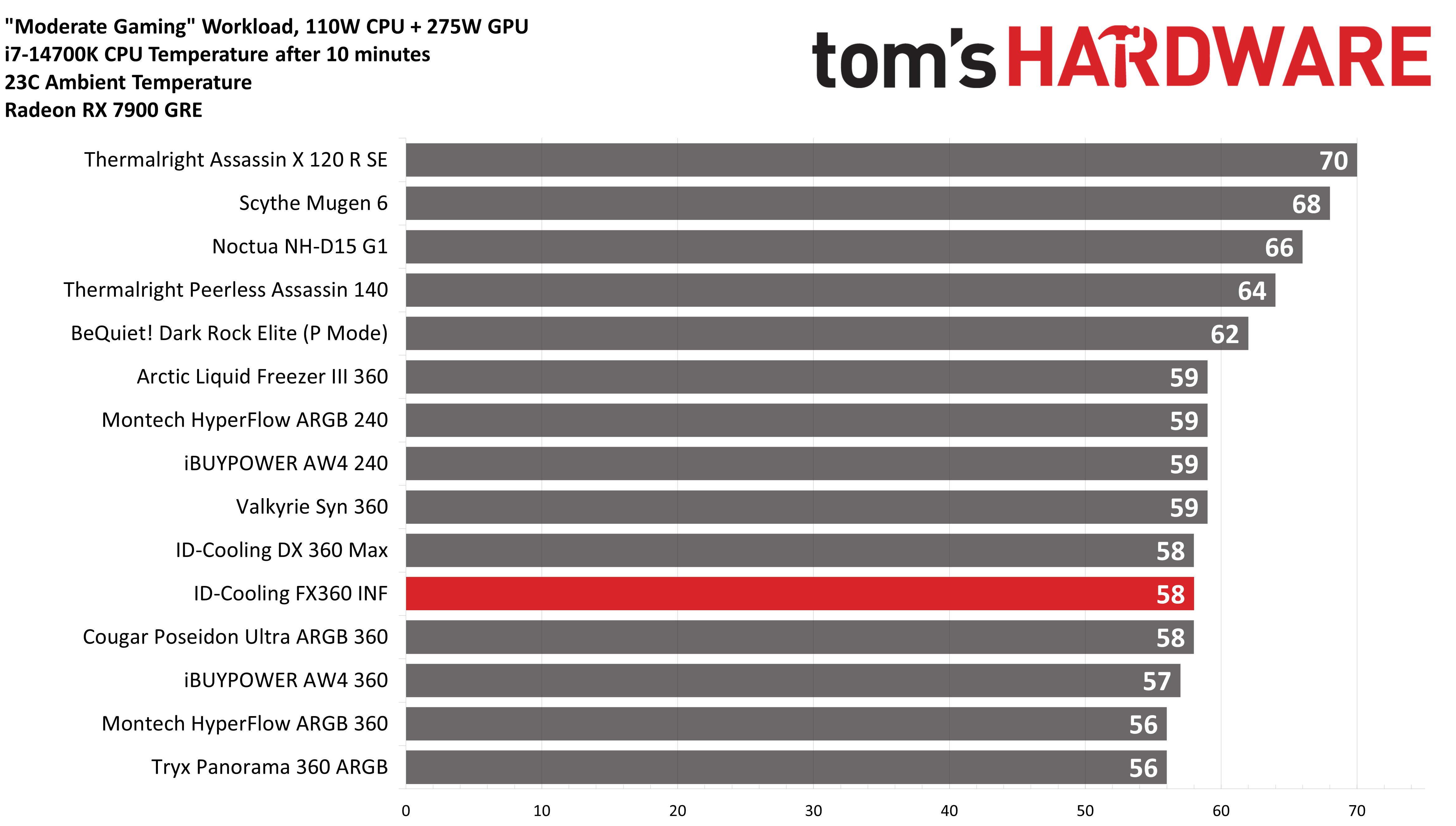Why you can trust Tom's Hardware
CPU Thermal results without power limits
Without power limits enforced on Intel’s i7-14700K, the CPU will hit its peak temperature (TJ Max) and thermally throttle with even the strongest of air coolers and even most liquid coolers on the market. When the CPU reaches its peak temperature, I’ve measured the CPU package power to determine the maximum wattage cooled to best compare their performance.
ID-Cooling’s FX360 INF sustained an average CPU package power of 259W, just a bit ahead of the previously tested DX360 Max.
It’s important to note that thermal performance can scale differently depending on the CPU it’s being tested with. I’ve recently tested the FX360 INF as part of my initial cooling tests with Intel’s Core Ultra 9 285K, and it performs very well with the Arrow Lake CPU – allowing it to sustain full, unthrottled performance.

To sustain this level of performance, the FX360 INF reaches up to 44.4 dBA. This is a moderate noise level; it shouldn’t bother most folks – though some will prefer quieter noise levels.
Observant readers will notice that the graph starts at 35dBA, and might be worried that this starting point may cause graphs to be deceptive. But noise level measurements are logarithmic, so a person with typical hearing will perceive a doubling of noise for every 10 dBA increase, but the impact can vary from person to person.
Subjectively, I feel that a 5dBA increase feels like twice as loud – but I should add the disclaimer that I suffer from conditions that can make my ears more sensitive than others. 35dBA was also chosen as the “zero” for our charts because it is the lowest level my noise meter can accurately measure.
Thermal results with noise normalized to 38.9 dBA
Finding the right balance between fan noise levels and cooling performance is important. While running fans at full speed can improve cooling capacity to some extent, the benefits are limited and many users prefer a quieter system.
Get Tom's Hardware's best news and in-depth reviews, straight to your inbox.
With this noise-normalized test, I’ve set noise levels to 38.9 dba. This level of noise is a low volume level, but slightly audible to most people. The DX360 Max’s result of 248W puts it, within a margin of error, on par with Arctic’s Liquid Freezer III.
165W CPU + 275W GPU results
I’ve recently updated my testing methodology to better represent real-world scenarios a user might actually encounter. The first of these new tests is designed to emulate (though it’s not perfect) a CPU-intensive game with a full GPU load. Because the CPU load is constant, this test is a bit more difficult than an actual game would be– I would consider these results to be more comparable to what someone might see after overclocking. At 71C, the FX360 INF ties for the 3rd place best results we’ve seen on this testing setup.
When tied to the default fan curve of my motherboard, the fans have a relatively low noise level of 40.9 dBA – one of the quietest results we have from this test setup.
110W CPU + 275W GPU results
Our second round of CPU + GPU testing is performed with a lower CPU power limit, and in theory should be similar to games that are moderately intensive for a CPU. ID-Cooling’s FX360 INF performed well here. The CPU’s average temperature of 58C is only 2C behind the best results I’ve recorded, tying for third place.
120W Cinebench results
With my previous testing methodology, I used to record the temperatures and noise measurements using a 125W CPU-only test, and I would emphasize how temperatures do not matter in this scenario.
As such, for this section, I’m only going to report noise levels here. The temperature of the CPU in this scenario is largely irrelevant, but the results for liquid coolers are similar to those reported above in the 110W + GPU tests if you are particularly concerned about this information.
Noise levels were very low for the FX460 INF, reaching only 38.2 dBA – the sound level of this system when components are idle. This is a very good result and means in most situations you shouldn’t notice the noise of the liquid cooler.
Conclusion
ID-Cooling’s FX360 INF has strong thermal performance, low noise levels, and a budget-minded price tag of only $79.99 USD. What more could you ask for in a liquid cooler?!

Albert Thomas is a contributor for Tom’s Hardware, primarily covering CPU cooling reviews.








